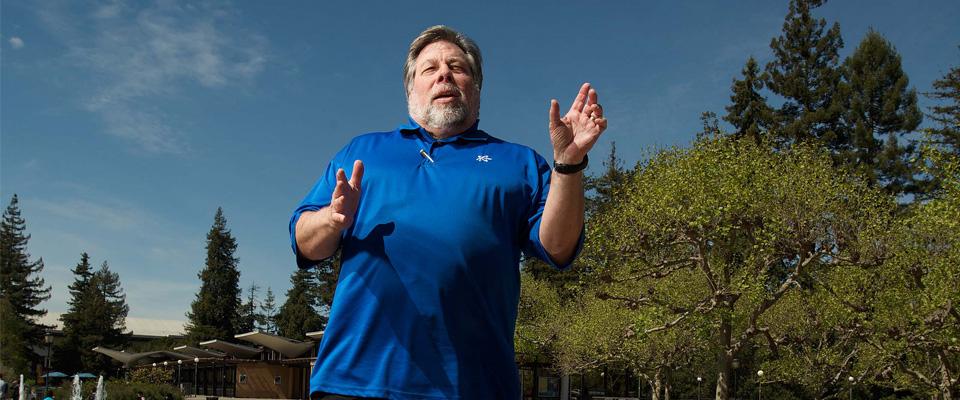For a brief moment, back when the tech revolution was young, I was an early adopter.
I was sucked in by that 1984 Apple ad that ran during the Super Bowl. I can’t recall a thing about the game, but I remember every detail of that ad: the woman running in her tank top one step ahead of the goons; the rows of corporate weirdos staring in open-mouthed horror; the hammer sailing toward the giant screen, smashing the Big Brother cult.
I had no idea what it meant, really, but like all the other freethinkers, I did what Steve Jobs wanted me to do. I went right out and bought the ultimate high-tech self-empowering supertool—a Macintosh computer.
My father-in-law, an accountant, asked me what the computer did that his calculator couldn’t do. I didn’t actually know, but I told him my Mac had a gigantic memory, a full 128 kilobytes. I drew a clown for him in MacPaint.
“Wow!” he said, impressed. “My calculator can’t do that.”
That computer was all I would ever need.

The guy at the MacAdam store on Folsom recommended an upgrade to 512K. But 128K was huge. More than enough to hold two or three pages of text, plus cutting-edge graphics in the futuristic plaids of MacPaint. I could draw a clown and make his nose change from dark gray to light gray. Or futuristic plaid. And I had plenty of extra Ks on my floppy disks, which in those days fit perfectly in my shirt pocket.
That was all I needed.
No way was I going to be suckered into a memory upgrade. I had all the memory I needed. Instead, my first upgrade was a special Mac-sized padded carrying case, complete with handle and a pocket perfectly sized for my collection of self-empowering floppy disks. It had Velcro. And a shoulder strap so I could carry my Mac out to my VW Bug without it getting wet in the rain. I could sling it into the back seat, like that girl slinging her hammer, and nothing would break. I could cruise over Altamont Pass and sashay into my media-pioneer job at the Stockton Record, where I was a road warrior, a Power User, well out on the cutting edge of the high-tech revolution. Few others at the Record had nearly as many clown nose variations on their floppies as I did.
Then I heard about clip art. Wow! Their clowns were fantastic. All I needed was 512K.
And a “modem.” What’s a modem?
Whatever it was, I saw no need for it. Until somebody explained to me what a modem was. Holy George Orwell! I needed a modem. This was it. No more upgrades. Then my VW died, my father-in-law got a PC, I moved a couple of times, and somebody told me about a new kind of Mac that had a built-in modem. Or something like a modem. It came in different colors. These machines were like sculpture, unlike the PCs, which looked like tools of the oppressor.
And on my new Mac, I’d be able to send long letters to people, without the need for stamps, so long as they had a modem, too. I just needed “email,” whatever that was. No way!
Soon, boosted no doubt by my burgeoning reputation as a Power User, I was a reporter at the San Francisco Chronicle, making more than enough money as a media celebrity to afford the latest Mac sculpture and clown-drawing software. It came with “email.”
So, why not? After all, I would need no further upgrades.
I can’t recall how much memory I had by then, but something called the Internet was starting up, along with a clown-rich area known as the World Wide Web. Who needed that? I could draw my own clowns. No way would I buy anything “online,” whatever that meant.
Then I saw an ad for a handmade sweater from Germany, made by a woman who reminded me of the hot runner in the Mac ad, the one in the tank top. I found her website. It had a note on it telling me that the woman personally knew my sweater sheep, Hilda, and both she and Hilda had email addresses! I knew what I had to do. I bought the sweater online, and I got email.
Soon after, I read that “the bloggers,” whoever they were, had decided all the music in the world could be “digitized.” Albums, they added, were now worthless. No way! Neil Young himself had recently declared CDs to be terrible. So I buttoned up in my sweater, put on “Heart of Gold,” and swore never to buy a CD. I was like the woman in the Apple ad, throwing hammers into the very teeth of Big Brother.
My next car came with a CD player built right into the dash. I had to admit it: CDs were convenient. You could use them as coasters. They fit in jacket pockets. I got into CDs. I sent an email: “Sorry, Neil!”
But there were limits. As a longtime reporter, there was no way I would ever subscribe to anything online, like the Chronicle. I took my news straight, or folded up, the way news was meant to be taken. And of course I would never give anyone my password (which, by the way, is ClownsR2evilHaHa).
Then Facebook happened. Who knew? No way would I ever “share” anything or “friend” anyone or reveal my “relationship status” (which, by the way, is “complicated, but willing to change”).
Eventually, of course, my father-in-law got on Facebook, and so I had to stay current. That was the last time I would fall for anything like this.
Until one of my 17 Facebook friends alerted me to a new thing called Twitter or Tweetie or something like that. I would need to be “tweeting” or “twixting” pretty damn quick or would never work in this town again. So I signed up. I tweeted “Help! What’s Instagram?”
I got an answer, by email, from Hilda: “Stop following me,” she said.
More Journalists’ Confessions:
Lucky Duck

Confessions of a hook-and-bullet reporter
Read more »
Clothes Made the Man

Confessions of a former fashion writer
Read more »
How I Killed Journalism

Confessions of an online journalist
Read more »
In Cold Pizza

Confessions of a crime reporter
Read more »
Hope Less

Confessions of a sex columnist
Read more »





















